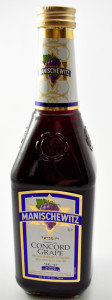Being that this coming Saturday evening marks the beginning of the Jewish festival of Purim, a holiday in which celebrants are commanded to get drunk with happiness (meaning: drink lots of wine), we thought it would be appropriate to delve into the history of a wine that, for many who are Jewish, was the first wine they ever drank. We’re talking, of course, about Manischewitz.
If you are Jewish, you probably first drank Manischewitz while celebrating a bar mitzvah, or you snuck a glass from your parents’ liquor cabinet, since it was the wine they barely ever drank, except on Friday nights. If you aren’t Jewish, don’t feel left out, it is quite possible you’ve drunk Manischewitz too, most likely one night in college when you were flat broke and decided to go for the cheap stuff on the lowest row in the wine aisle. No matter how you first consumed Manischewitz, once you’ve sipped it, you never forget its sweet, syrupy taste. Not to mention the terrible hangover the next morning.
So what exactly is Manischewitz, and how did it become so widespread across the country? Genius marketing.
In the 1940s, the enterprising owners of the Monarch Wine Company, which was based in Brooklyn, set out to create an affordable kosher wine to sell to the one-and-a-half million or so Jewish immigrants who had settled in New York City over the previous few decades. While the majority of Jewish immigrants had arrived in the US by this time, many were still arriving every day, as New York City’s Jewish population did not peak until the 1950s. These immigrants were looking not only for a better life in America, but also to practice their religion freely, which meant they’d be looking for kosher wine. Monarch saw an opportunity to be the player in the market.
One problem: in the 1940s, when Monarch Wine came up with their genius idea, their company name meant nothing to people. So, in order to remedy the situation, the executives of Monarch approached a successful business based in Cleveland, OH that had become well known for making matzo and other kosher foods, The Manischewitz Company. The owners of Monarch proposed to Manischewitz a licensing deal: they would pay the company a fee in exchange for Monarch gaining the right to use their name on its new kosher wines. Because at the time Manischewitz had no interest in making wine themselves, they agreed.
After Monarch secured the licensing deal from Manischewitz, they set out to find grapes to make their wine. The company chose to source Labrusca grapes from upstate New York, a location that was ideal because it was close enough to the city for the grapes to be picked and then shipped down from the vineyard to Brooklyn, where they could be crushed and fermented under strict rabbinical supervision.
In order to make enough wine to satisfy market demand, Monarch needed to source a ton of fruit; however, in those days the quality of the massive number of grapes coming from upstate New York was not always ideal, which often would result in certain batches producing wines that were bitter and unpalatable. To ensure the wines were drinkable, sugar was added to the wine, giving it a distinct, sweet flavor similar to Concord grape juice. It was this adding of sugar that cemented Manischewitz’s reputation as the sweet, syrupy, red wine for which it has become famous, or, depending on how you look at it, infamous.

For the first twenty or so years of the wine’s life, Manischewitz was a brand known only by members of the Jewish community, but everything changed in the 1960s when the “Man, Oh Manischewitz” commercial starring Sammy Davis Jr. premiered. In the commercial, Davis Jr. sings about how wonderful the wine is and the commercial and phrase became a viral hit. The commercial was so popular in fact that Apollo 17 astronaut Gene Cernan was recorded during his spacewalk saying “Manischewitz, look at that go! Did you see that?” During the Apollo mission it was reported that Cernan often used “Manischewitz” as an exclamation or as a substitute for swearing.
Today, Manischewitz Wine is made by Constellation Brands, still using grapes grown in upstate New York and it is still as ubiquitous as ever on festive holiday tables. The wine is also still produced under a licensing deal with The Manischewitz Company, which is now owned by the R.A.B. Food Group, a private company dedicated to kosher foods, and can be found globally.
If you were wondering if any of the members of The Manischewitz Company ever got into making wine themselves, they actually did. Recently, the son of the current owners of The Manischewitz Company has launched a non-kosher boxed wine brand called Public House Wine. Wine making and celebrations are clearly in the family blood.
